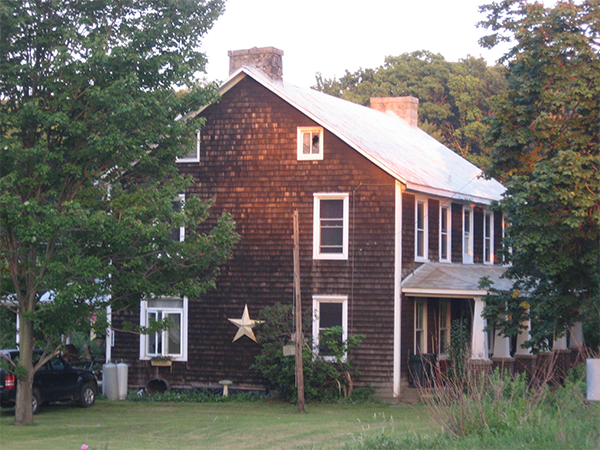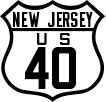 |
Augustine's Tavern (closed)
Formerly/Also Known As Wable Tavern, Pleasant Vale Hotel, Jones's Tavern, Whetstone's Tavern, Cresap's Tavern
Addison, PA 15411From Searight's The Old Pike (1894):
At the foot of Winding Ridge, on the north side of the road, an old wagon and drove stand was kept as early as the year 1820, by John Wable. This old tavern keeper was probably well advanced in years when he first put out his sign, and from this old house he was summoned to his last account. He had two sons, John and Jacob, who succeeded him in the management of the old tavern, as tenants in common. The sons applied themselves assiduously to the business of entertaining the public, and after a brief experience, concluded that their father's old house was too small to meet the demands of the increasing trade and travel of the road, and accordingly tore it down and erected a new and larger one in its place. The new house attracted a paying business, and remains a well known landmark of the road. In course of time the Wables left this house, and their successor was Edward C. Jones, the grandfather, on the maternal line, of Caleb and Noble McCormick, of Uniontown. This was more than fifty years ago. Mr. Jones moved from this old house to Searights, where he resided for a time, and subsequently located in New Salem, where he died. The old Wable house next passed to the hands of Jonas Augustine, who became its owner and conducted it as a tavern for many years, doing a good business. While in charge of this old tavern he was elected a member of the legislature of Pennsylvania for Somerset county, and represented his constituents with recognized fidelity. He died soon after his legislative career ended, and the old tavern was purchased by his brother, Daniel Augustine, who kept it for many years, and until tavern keeping on the road ceased to be profitable. Previous to the occupancy of Daniel Augustine, this house was kept for brief periods between 1840 and 1845, first by Michael Cresap, and after him by Joseph Whetstone. Cresap went from this house to the stone house on Winding Ridge. The widow of Jonas Augustine, well advanced in years, occupies this old house at the present time, as a private residence, and Daniel Augustine is a resident of Petersburg, and regarded as the richest man in that town.
From the National Register of Historic Places Nomination Form (1995)
The Wable/Augustine Tavern is situated on the north side of U. S. Route 40, approximately one mile east of Addison, at the foot of Winding Ridge. Like all the National Road taverns, not only is it situated near the road, but faces the road as well. It is surrounded by a tree shaded lawn. The grade of Route 40 was raised in the twentieth century so that it is much higher than the tavern's entrance level. This c. 1820, five-bay, double pile, two-and-a-half story frame house was built in the Georgian plan with a central hall. The house is distinguished as a tavern by its relatively large size and interior stone gable end chimneys. Although changes have been made to this property over the years since its construction, it retains sufficient integrity to represent the earliest period in the development of the National Road.
The building rests on a low rubblestone foundation. The front door and its surround are indicative of its Federal period construction date. There is an arched transom above the door. The pilasters on either side have an oval corner block. The first floor front windows have similar corner blocks and quarter round molding. An early twentieth century porch replaced an earlier porch along the entire front of the house. The new porch features tapered square columns, typical of the Craftsman style, resting on brick bases which support the hipped porch roof. Another porch was added to the rear of the house in the mid to late twentieth century. Wood shingles were added to the exterior walls in the late twentieth century.
Most of the windows of the Wable/Augustine Tavern retain their late nineteenth/ early twentieth century two-over-two configuration. The central front door opens into the stair hall which provides access to three of the four first floor rooms as well as to the opposing rear door and the stairs. There are six raised panels on the interior of the front door. The original molded door surrounds with corner blocks survive in the hall. The hall also retains its baseboard with a molded top and a low chair rail with a molded bottom. These continue along the wall up the open staircase. The balustrade features a turned newel post, rectangular spindles, and a carved handrail. Curvilinear molding is applied to the stringer beneath each tread characteristic of the Federal period. (In other words, the stringer is bracketed. ) Instead of the more common recessed panels beneath the staircase, the plastered wall is embellished with a chair rail and baseboard. The doorways from the hall into the two western parlors have a reeded reveal, another feature of the Federal period. The walls of the back-to-back corner fireplaces dominate the space of these two parlors. The fireplaces have been blocked in. The rear parlor has been converted into a modern kitchen. The west window in the kitchen was enlarged in the early to mid-twentieth century. There is an exterior rear door into the kitchen as well. The east front parlor is the largest room on the first floor. It contains a fireplace along• the east wall. Formerly, a door entered from this room into the small room behind it. While this entrance has been closed off, another entrance was created by going through underneath the rear of the staircase. There is an exterior rear door into this small room as well.
The four rooms and hall on the second floor are largely intact including the chair rail and window and door surrounds for these rooms. However, the moldings are not wide or detailed here. The staircase was originally open to the attic. Sometime in the late nineteenth/early twentieth century it was enclosed. The original plastered side wall into the attic was stenciled. Although faded, it is intact. The attic is high, about ten feet at the apex. (The roominess of the attic would certainly have allowed for overnight guests there as well.) The rafters are only hewn on their top side and are mortised and tenoned at their apex. Two small windows light each gable end of the attic.
On the rear porch is a wooden painted sign inscribed 'Pleasant Vale Hotel. ' Evidently, this is the sign from this building's last use as a public house. Sometime in the twentieth century, the one story, frame kitchen ell was removed.
Although alterations, such as replacement exterior siding, twentieth-century porches, and sheathing of fireplaces have been made to the Wable/Augustine Tavern, it is still able to convey its early nineteenth century significance in association with the National Road. The building retains good integrity overall, and the character and feeling of the property remains intact.
The Wable/Augustine Tavern is significant in the areas of commerce and• architecture. This building is part of the property type of 'Tavern Buildings' as discussed in Historic Resources of the National Road in Pennsylvania Multiple Property Documentation Form. Among the requirements to meet Criterion A the tavern must be documented to be associated with the National Road. To meet Criterion C a tavern must possess architectural integrity which means it should still be identifiable as -a tavern through its form and basic floor plan. This building has been documented as a tavern from the 1820s, and it retains its form and floor plan from that period. The Wable/ Augustine Tavern is one of just a few wood/frame tavern buildings surviving along the National Road. The vast majority are of masonry construction. It is also the best example of a surviving tavern associated with the National Road in Somerset County.
This building was built by John Wable during the earliest period in the development of the National Road. The house's construction date is based on its Federal style details and its back-to-back fireplaces. (Georgian plan houses with back-to-back corner fireplaces were generally built in Pennsylvania from the mid-eighteenth century to the early nineteenth century.) This was a period of rapid development along the National Road. There were four taverns listed in Addison Township in 1818 J but by 1820 there were seven. The 1846 assessment for the township showed four taverns and seven innkeepers. But by 1855 the number of innkeepers had dropped to three. This National Road boom period of the 1820s to the early 1850s roughly fits the use of the Wable/Augustine property as a tavern.
Wable family members were early residents of Addison Township. The earliest records of John Wable purchasing land in Addison Township could not be found. By 1818 he owned 223 acres in the township with 40 of these acres cleared. In 1823 he was assessed with three tracts totaling 457 acres. He added to his holdings in 1825 with a purchase from William McLean. Although Searight states that John Wable kept a 'wagon and drove stand' as early as 1820, Wable was first taxed as an innkeeper in 1826. By 1828 John had died J leaving a widow and nine children. An 1829 Orphans Court record noted among his property a 245 acre tract 'on both sides of the National Pike with a tavern house and a stable.' An inquisition upon the estate found that the estate could not be divided among all the heirs without spoilage to the whole. Therefore, Jacob, the eldest son, was allowed to take the property at the value set by the group of inquisitors. Jacob was taxed as an innkeeper in 1829.
Jacob continued to be assessed with a tavern or as a tavern keeper until 1835 when his brother John was taxed as such. In 1836 Jacob Wable deeded to his brother John one half interest in four tracts 'on or near the U. S. turnpike road in Addison Township. II Jacob had just received a patent on three of those tracts that same year. The four tracts were to be 'held between them as equal partners. ' John continued to be assessed with a tavern until 1839 when Jonas Wable was taxed with the property. Jonas continued to own land in Addison Township, but Michael Cresap was taxed as an innkeeper in 1843 and 1845. In 1843 Jonas deeded his one half share in the tavern property to Peter Augustine. This is confirmed by Thomas Searight's account, which states that by the 1840s the Wables had left the property, and it was kept for brief periods between 1840 and 1845 by Michael Cresap and Joseph Whetstone.
Searight lists the tavern's next proprietor as Edward C. Jones, who then moved on to Searight's stand. Jonas Augustine followed Jones. Evidently, Jonas was in partnership with Peter Augustine, and they did not get a clear title to the property unti11859 when the widow of David Wable quit claimed her right in the property. During Jonas's ownership he served as a state representative in 1855 and 1856. Searight noted that Augustine conducted a good business there. Augustine died soon after 1856, and the tavern was purchased by his brother Daniel. In 1894 Jonas's widow was using the tavern house as a residence, and Daniel Augustine was living in nearby Petersburg (present-day Addison).
The tax assessments present a little different chain of events in the life of the Wable/Augustine Tavern. The 1846 tax showed Peter Augustine with the 210 acre tavern property, and in 1848 Daniel Augustine had the same property. None of the Augustines were listed as innkeepers during this time. In 1850 Jonas Augustine had the 210 acre property, but he was listed as a merchant. In 1851 Jonas continued as a merchant, and Daniel was listed as an innkeeper. The 1852 and 1853 records showed both Jonas and Daniel as innkeepers. Daniel continued as an innkeeper through 1855 but Jonas was shown as a farmer. Apparently, this property no longer was operated as a tavern after this time.
The 1987 survey of the National Road identified other taverns in Addison Township. These included the frame Gabriel Abrams Tavern which was determined not eligible due to loss of integrity. The brick Mitchell Tavern, also known as the Augustine House, was determined eligible on its architectural significance, but could not be positively documented as an actual tavern location. The log Augustine Tavern, also in Addison Township, was demolished in 1985. Therefore, the Wable/Augustine Tavern is the best example of a tavern associated with the National Road in Somerset County.
The Wable Augustine Tavern is significant not only for 'its association with the early commercial development of the National Road but as a good example of vernacular tavern house architecture with Federal style details as well. View user comments below.
|
 |
 |
Augustine's Tavern. Photo: Wikipedia.
|
For more information:
No comments have been posted.
Feedback: Do you have corrections or contributions for this page? Want to make a suggestion? Click here to send me an e-mail. I am espcially interested in memories, stories, postcards and photographs. Thanks!

Last updated: 2014-04-05 16:33:03 |
 |
|


|
|
































